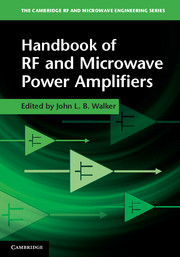Book contents
- Frontmatter
- Contents
- Contributors
- Preface
- 1 Silicon LDMOS and VDMOS transistors
- 2 GaAs FETs – physics, design, and models
- 3 Wide band gap transistors – SiC and GaN – physics, design and models
- 4 Amplifier classes, A to S
- 5 Computer-aided design of power amplifiers
- 6 Practical HF/VHF/UHF RF power amplifier realization
- 7 Microwave hybrid amplifier realization
- 8 Monolithic power amplifiers
- 9 RF power amplifier thermal design
- 10 Reliability
- 11 Power amplifier applications
- 12 Amplifier measurements
- About the authors
- Index
- References
8 - Monolithic power amplifiers
Published online by Cambridge University Press: 05 November 2011
- Frontmatter
- Contents
- Contributors
- Preface
- 1 Silicon LDMOS and VDMOS transistors
- 2 GaAs FETs – physics, design, and models
- 3 Wide band gap transistors – SiC and GaN – physics, design and models
- 4 Amplifier classes, A to S
- 5 Computer-aided design of power amplifiers
- 6 Practical HF/VHF/UHF RF power amplifier realization
- 7 Microwave hybrid amplifier realization
- 8 Monolithic power amplifiers
- 9 RF power amplifier thermal design
- 10 Reliability
- 11 Power amplifier applications
- 12 Amplifier measurements
- About the authors
- Index
- References
Summary
Overview of MMIC power amplifiers
Over the past 30 years, microwave power amplifier (PA) technology has gone through a significant evolution to meet necessary requirements such as high-power, high-efficiency and high-voltage operation for lower-cost solutions, circuit miniaturization, improved reliability and high-volume applications. PA component size and weight are prime factors in the design of electronic systems for satellite communications, phased-array radar (PAR), electronic warfare, and other airborne applications, whereas high-volume and low-cost drive the PAR and consumer electronics market. Monolithic microwave integrated circuit (MMIC) power amplifiers are the key to meeting these requirements. In MMICs all active and passive circuit elements are fabricated together on a semi-insulating GaAs substrate. MMIC amplifiers are integral parts of most commercial and military systems.
For radio frequency integrated circuit (RFIC) wireless applications, several Si-based device technologies including bipolar, CMOS, BiCMOS and SiGe HBT are being pursued to obtain an optimum solution in terms of performance and cost for low-power applications. In the Si based processes, Si wafers are larger and cheaper than GaAs wafers but the fabrication involves a relatively larger number of process steps. RFICs are generally partially matched and require off-chip elements to complete the matching. Both RFICs and MMICs have low Q passives, expensive nonrecurring engineering cost, long development cycle time and in MMICs no post manufacture tuning or “tweaking” to obtain the optimum performance. Power levels in an MMIC approach are much higher than those that can be realized using an RFIC technique because of breakdown voltage considerations. Therefore, Si based RFICs will not be included in this chapter.
- Type
- Chapter
- Information
- Handbook of RF and Microwave Power Amplifiers , pp. 357 - 410Publisher: Cambridge University PressPrint publication year: 2011
References
- 1
- Cited by



